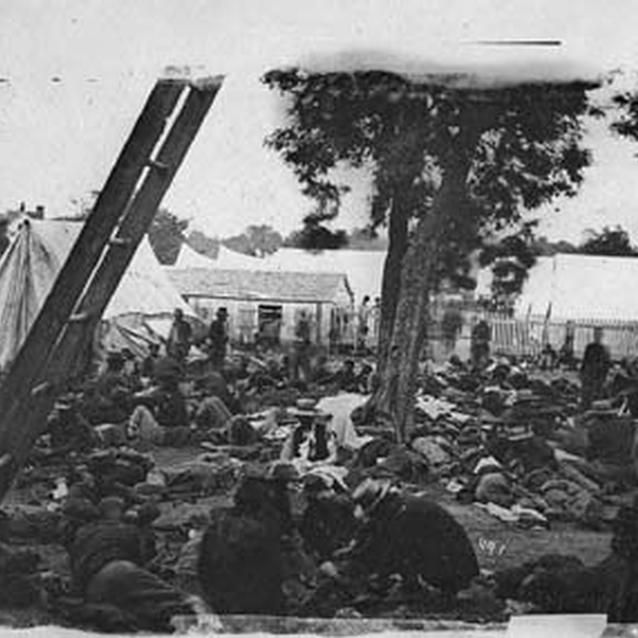The story of Civil War medicine is a complex one. Through the dedication, innovation and devotion of surgeons and medical support staff, the foundation for today's modern military medicine was laid.
"Humanity teaches us that a wounded and prostrate foe is not then our enemy." Dr. Jonathan Letterman
The Traveling Medical Department

Library of Congress
After the Battle of Antietam, both Medical Departments were faced with the daunting prospect of treating and transporting a large number of wounded men. The newly-organized Union Ambulance Corps was helpful in the evacuation of the soldiers who could be moved, and a new concept of semi-permanent field hospitals was tested for the first time. It was an experiment brought on by necessity, since there were so many soldiers with serious injuries who could not bear even the twenty mile trip to more established hospitals in Frederick.
The Confederate wounded who could not be moved were treated by the Union Medical Department, and all received the same level of care as the Union wounded, for, as Dr. Jonathan Letterman stated, "humanity teaches us that a wounded and prostrate foe is not then our enemy."
Before the Battle of Antietam, Dr. Letterman arranged for the Medical Purveyor in Baltimore to gather supplies and have them ready to be shipped where and when he asked for them. Unfortunately, the destruction of the railroad bridge at Monocacy Junction near Frederick, Maryland, delayed the supplies in reaching the field hospitals at Antietam. Also, since medical supplies were shipped by the Quartermaster Department and not the Medical Department, they were often set aside in favor of other items like ammunition and food. These delays caused Letterman great frustration, since most of the medical supplies did not arrive at the field hospitals until four days after the battle.
From his experiences at Antietam, Letterman changed the way medical supplies were distributed to the regiments. He noticed waste occurred when large amounts were given out, and the abandonment of supplies when adequate transportation could not be found. He reduced the amount of medical supplies given to a regiment at one time, thus making the system more efficient. On October 4th, 1862, the new supply system was adopted. One wagon now sufficed for the medical supplies of a regiment, plus the hospital tents and baggage of the medical staff, with one additional wagon for a brigade.
"The [new supply system was intended to] reduce the waste that took place when large supplies were at one time issued to regiments, to have a supply given them, small, but sufficient for all immediate wants, and to have these supplies easily attainable, and replenished without difficulty, when required, and without a multiplication of papers and accounts." - Dr. Jonathan Letterman
Improvements to the System

Library of Congress
The Civil War is considered a watershed in the history of medicine. Many of the innovations implemented during the war helped to bring the practice of medicine into the modern era, including:
-Advancements in surgical procedures and the management of traumatic wounds, including specialization in plastic surgery and nerve injuries
-The establishment of an organized ambulance system with trained stretcher-bearers
-The creation of a multi-layered system of care on the battlefield that included first aid stations and field hospitals
-The use of triage to maximize the survival rate of the patients
-Widespread use of anesthesia during surgery
-The establishment of fixed-bed hospitals as long-term care facilities
-The introduction of women into the hospitals as nurses, laundresses and hospital administrators
-The organization of civilian relief agencies that worked with the military to provide supplies, clothing and food
-Improvements in orthopedic medicine and the design of prosthetics
-Documentation of wounds, illnesses and treatments with the intention of using the records as a teaching tool
The Legacy of Civil War Medicine

Library of Congress
The story of Civil War medicine is a complex one. Through the dedication, innovation and devotion of surgeons and medical support staff, the foundation for today's modern military medicine was laid.
Unfortunately, little was known about the psychological damage suffered by those who had experienced the horrors of war. While it was recognized that war changed people, diagnosis and treatment of the emotional impact of combat had yet to be fully understood. Some people could not cope with their experiences and were traumatized for the rest of their lives. Others found ways to overcome the mental and physical trauma and enjoyed success after the war. Veterans groups came together to help support their stricken brothers. Of great importance is the fact that what was learned during the war was shared with the world, greatly adding to the quality of health care for everyone.
Advancements in medicine made during the war allowed wounded soldiers to return to their homes and lives. Medical professionals and the compassion and service of dedicated civilians kept them alive and gave them hope. Their own strength and resilience made them heroes.
Part of a series of articles titled A Most Horrid Picture.
Previous: Organization is Key
Last updated: August 11, 2017
